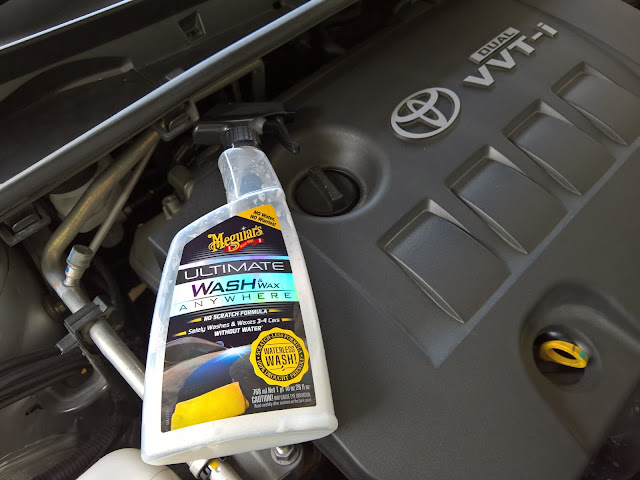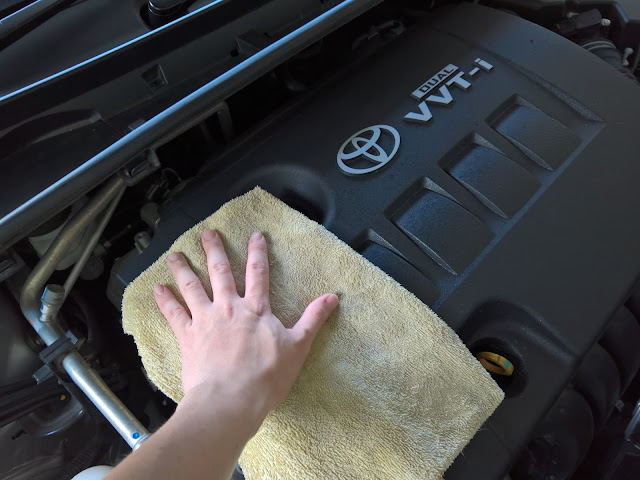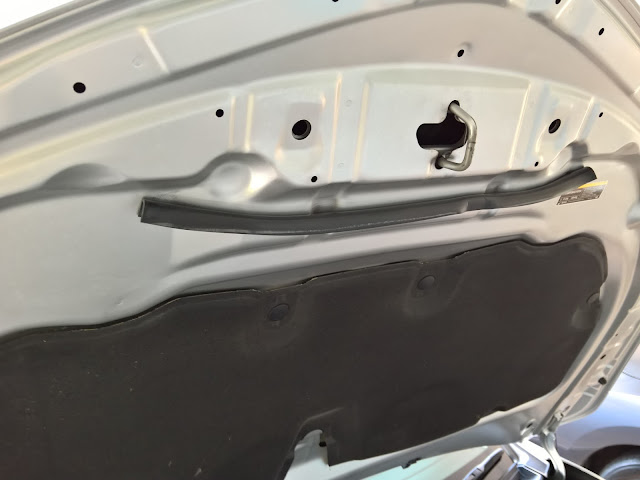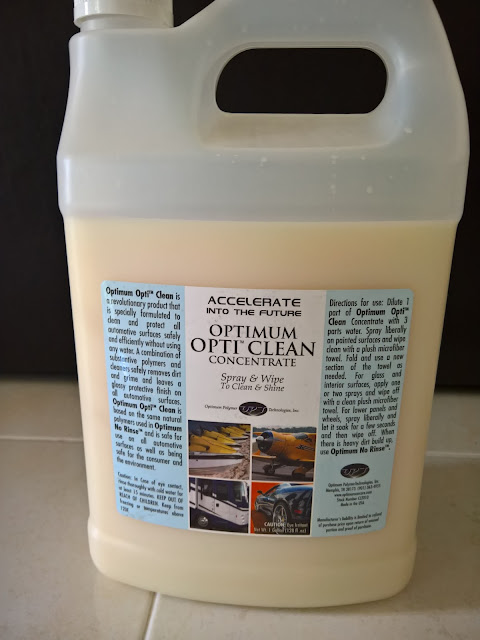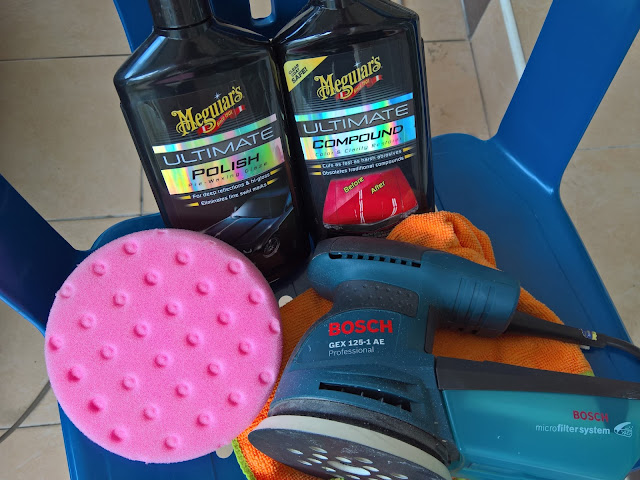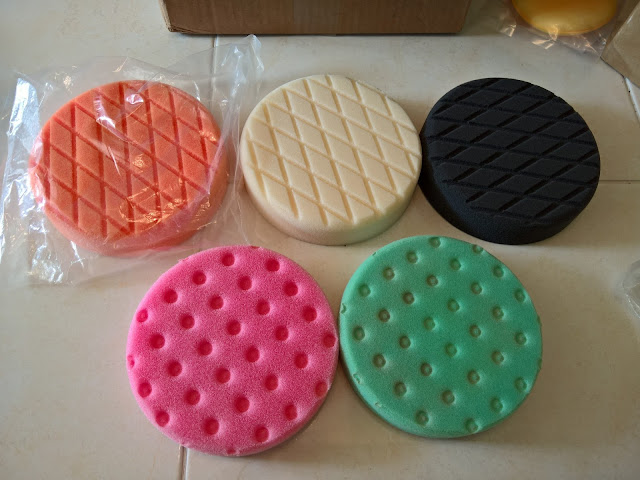Before we go into the steps that I normally take, let us; very briefly; discuss compounding, polishing, and waxing. Some people may be confused that polishing and waxing are the same thing. Technically, they are not but with the introduction of all-in-one products than combines polish and wax in one product, it is easy to get confused. So let us discuss this in a less technical manner and not go scientific ;-)
Products
Compound
Compounding is used for paint correction. A compound has harsher abrasives in it and when used with a cutting foam pad or microfiber cutting pad, it can cut off thin layers of paint or clear coat. Compounding is used to correct defects like scratches, water marks, oxidation, and heavier defects. Traditionally, a compound will leave a hazy finishing. However, newer products tend to blur the line as some compounds, especially consumer type like Meguiar's Ultimate Compound does not leaves a hazy finish as they want to make it more user friendly. For professional line, Meguiar's do offer the M105 Ultra-Cut compound and if I am not mistaken, it is meant to be used with a rotary buffer rather than a dual action/ random orbital buffer.
My products: Meguiar's Ultimate Compound. Planning to get Optimum Compound.
Polish
Consider polishing to be a step less aggressive than compounding. It can be used to remove minor defects like light swirl marks. It is also a follow up for compounding to remove compounding haze and it leaves a fine finish.
My products: Meguiar's Ultimate Polish, Autoglym Super Resin Polish
Wax and Sealant
Wax does not contain any abrasives and does not have any correction ability. It is used to protect the surface of the car. It acts as a barrier so that dirt and contaminant will not come directly into contact with the car surfaces. Apart from protection, it also add gloss and shine and some slickness that is fun to run your fingers on.
There are two kinds of waxes - natural and synthetic. Most natural waxes contain carnuba which comes from a tree. Carnuba itself is actually very hard and in order to be applied to car surfaces it has to be somehow "synthesized". Usually, only minute amount can be found in car waxes. Synthetic waxes are sometimes called sealant. They are fully synthetic.
So why these two? Some people argued that natural wax gives a more deeper gloss compared to synthetic wax. However, synthetic wax last longer. So for our climate in Malaysia, I would say that a natural wax will last 1-2 months and a synthetic wax 3-4, maybe.
Wax can be layered. In order to achieve the best of both world, some people would put a layer of synthetic wax and top it off with a natural wax. This will give a much deeper gloss, especially in dark-coloured cars, and last longer.
My products: Meguiar's Ultimate Paste Wax (synthetic), Autoglym Extra Gloss Protection (synthetic). I do not have any natural wax as my own daily drive is silver colour and most of my previous cars are light coloured. So I went for a longer lasting product and do not need the deep gloss. Might be a different story for my wifes daily drive now.
All in One
All in one products combined both polish and wax. However, the amount of abrasives are very little and can be used for very minor paint correction, if any. The wax would not last as long also. But this product earns it place in the detailing world because it is a time saving product. Instead of going step by step to polish, buff, wax buff, this product is a single step product.
My products: Meguiar's Cleaner Wax, CarPlan Triple Wax, Simoniz MaxWax, PermaGlass Polymer Sealant. Why so many? Well, I started off with these before going full fledge.
Moving on, we need tools to apply these products. I started off using elbow power. Applying these products by hand. Not only it is time consuming but correction are limited. But it is a good workout.
Then, I start exploring for power tools (of course with a tight budget). So here are some tools available in the market...briefly.
Tools
Rotary buffer
I consider a rotary buffer as the real pro tool. It has the most cutting power and needs many practices and good skills to handle. If not handled carefully, it will burn through the paint.
Dual Action Polisher/ Random Orbital Buffer
These are safer than rotary buffer and still offer good paint correction capability. Instead of just a rotating spindle, it oscillate in an eccentric circular motion. This dual action motion prevents burning of paint even if it stays on the same spot for long period. This is the to-go-to tool for most detailers and they are the most costly.
When I started to look for tools a few years back, these dual action tools are hard to find in Malaysia. Brands like Porter, Griott Garage, are almost impossible to find back then and will need a transformer as most are rated 110V. Recently Meguiar's introduced their 220V dual action polisher and it cost nearly RM2000. So I ended up with
Bosch GEX 125-1 AE. At that time, this is the most affordable tool that I can get. Some discussion of this tool
here and
here.
Random Orbital Waxer
Although this tool has random orbit, it lacks power for paint correction an is mostly use for wax application. Example is like
this. If you need something that can correct paint, at least go for a proper random orbital buffer.
Pads
There are several different kinds of pads from foam pads to microfiber cutting pads. I myself uses
Lake Country CCS pads and ZFE pads. These pads are color coded and have different densities for different purposes.
In the picture above the diamond pads are from ZFE and dimple pads are from Lake Country. The density is similar for:
ZFE orange = Lake Country Pink --> for very mild cutting and polishing
ZFE white = Lake Country Green --> for polishing/ finishing
ZFE black --> for wax sealant application
Applicator pads
These are pads used for hand application. For me, I usually use hand to apply final wax or sealant.
Methods
Now let us jump into how I go about working on a car, or in this case my wife's DD. After washing and cleaning a car in preparation of polishing (I use the word polishing as a representation for compounding, polishing, waxing), I will inspect the overall car condition. If the car is only with minor defects like very minor swirls, I will go straight into polishing. If there are heavier defects like scratches or watermarks, then I will go for compounding. Why do the unnecessary, right? If polishing alone can bring back the condition to acceptable level, then do not go for compounding. How acceptable is acceptable? Well it depends. If the car is a showroom car then acceptable levels will be almost perfect and if it is a daily drive, there is no point going OCD about it. As long as the car looks good to you, it is good enough. For me, if I park my car under a lamp, say a lamp post at night and I do not see "spider webs" like swirls or scratches, I am happy. Remember when you polish your car, you are removing nanometers or micrometers off from the car paint or clear coat. So, do not overwork it. Prevention is better than cure works here also. Try to maintain your car condition by washing it regularly, follow by spray wax every wash and wax every few months.
Alright, let's move on with the steps.

As can be seen above, there is some scratches on the front hood of the car. Here, I will start with the least aggressive method. I will first use polish to see if the scratches can be removed.
Priming the Pad
The first step is to prime the pad. To do this put some product (Meguiar's Ultimate Polish) on the pad and spread it evenly all over the surface of the pad with your fingers. In older methods, it was generally advised to draw an "X" with the product on the pad to prime it. Squeeze the polish from an applicator bottle to draw an "X". However most recently, there are new arguments that spreading the product evenly on the entire pad surface is better. With the product all over the pad surface, it is more difficult for dirt to get trapped in the pad. We do not want this dirt to get in between the pad and car surface during polishing as it will reduce the effect of the polish and may introduce more defects. So the idea is more on dirt management. Make sense doesn't it? I think so...So I became a dirt management man since then.
Let's Get to Work
So I started with polishing on a small area around the scratches to see if it will remove it. Always polish in small panels say maybe like 2' x 2' or even smaller.
First set the tool (DA or ROP) to a low speed and spread the product around the work panel. Once done, set to a higher speed. This will depend on your polishing tool. On my Bosch GEX 125, I usually set to speed 4-5. Start by moving in overlapping straight lines. Then switch direction to overlapping straight lines perpendicular to the initial lines. Switch back to the original straight lines and repeat a few times (a few passes). Sorry, I should have included a video here but there was nobody to help me to shoot a video. GoPro maybe?
In order for the polish to work, it needs to get broken down to small particles to abrade the paint. When first applied onto car surface, Ultimate Polish starts out whitish. After a few passes, it will "diminish" and turn almost clear. If you feel that a few more passes is needed, add more polish, around the size of a 20 cents coin (Malaysian sen) to the center of the pad and continue polishing.
So after polishing for a few passes, I used a clean microfiber towel to wipe off the polish residue.
As can be seen above, the scratches are still visible, albeit less obvious. With that, I decided to move to compounding. I used another clean foam pad and prime it with Meguiar's Ultimate Compound. I used a similar light cutting pad. As I am writing this now, I think that I will get a heavier cutting foam pad in future to save some number of passes and save some time. Anyhow, these are the pads that I have now.
After following the same working method for polishing mentioned above. I was able to remove the scratches. Then I continued to compound the entire hood, wiped off, and followed with polishing. The result was great.
For the rest of the surfaces, I just went straight into polishing.
After polishing a few panels, the polishing pad would get dirty. I normally set the polishing tool to a low speed and use a brush to brush off the dirt.
CAUTION: Do not compound or polish under direct sun light. Do not let them dry on the car surface. Work them in and wipe off panel by panel. If the compound or polish dried up on the car surface, use some spray wax to remove them.
Waxing
Once the entire car is polished and wiped clean, it is time to protect it. Compounds and polishes are use to correct paint and they do not have properties to protect paint. Unless we are using an all-in-one product, we need to protect the paint. This is where wax and sealant come in.
I used Meguiar's Ultimate Paste Wax for this time. It is a synthetic wax. Once on, with proper maintenance it should last for a few months.
Unlike compounds and polishes, we do not need to work in the wax. Just apply a thin layer of wax, let it dry and wipe off. This is why I prefer hand application rather than machine. I can easily wax the whole car in a 10-15 minutes.
For waxes and sealants, we will need to wait for wax or sealant to dry up and haze up. Waxes and sealants usually go on clear and haze up when dry. Some car care enthusiasts recommend leaving the wax on for a few hours or even over night before buffing it off. But if we do not have the whole day to work in a car a simple method to see if the wax is ready to be buffed off is to do the finger swipe test. Run you finger on the wax. If it comes off easily from the car surface, then it is dry.
Once all buffed off, enjoy the shine.
There you go. Compounding, polishing, and waxing. However these steps could not remove some defects. Those defect could be stone chips or dents. What I dislike the most are dents from other people knocking your car when they open the door of their cars parked next to you.
So, the next time when you open your car door, be considerate. Try not to bang somebody else's cars.
That's it for this post. Sorry for the long post but there are just too many things to share here.
Cheers!
